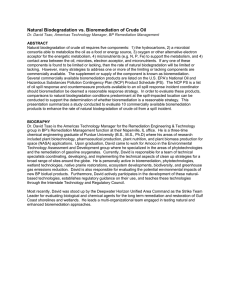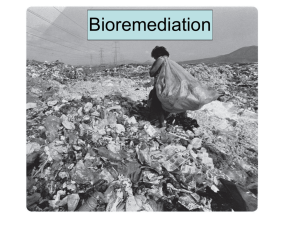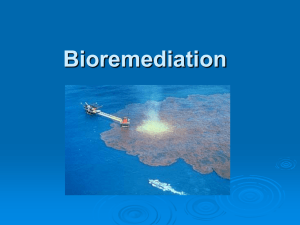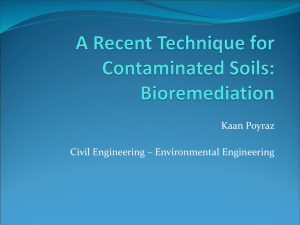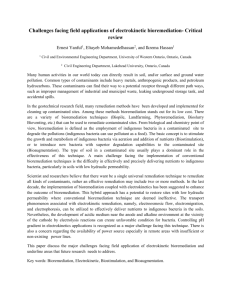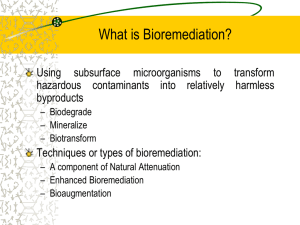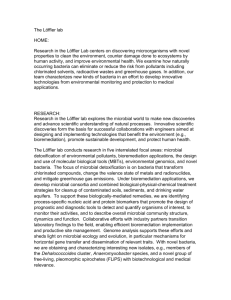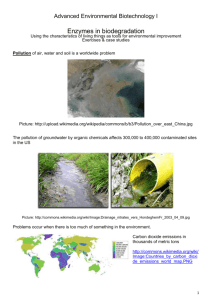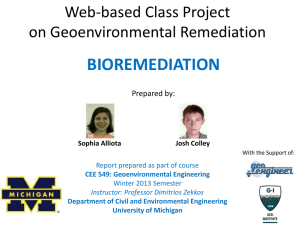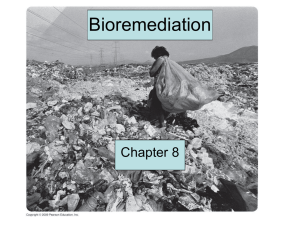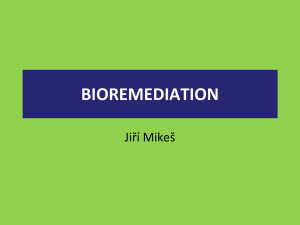Subject name
advertisement
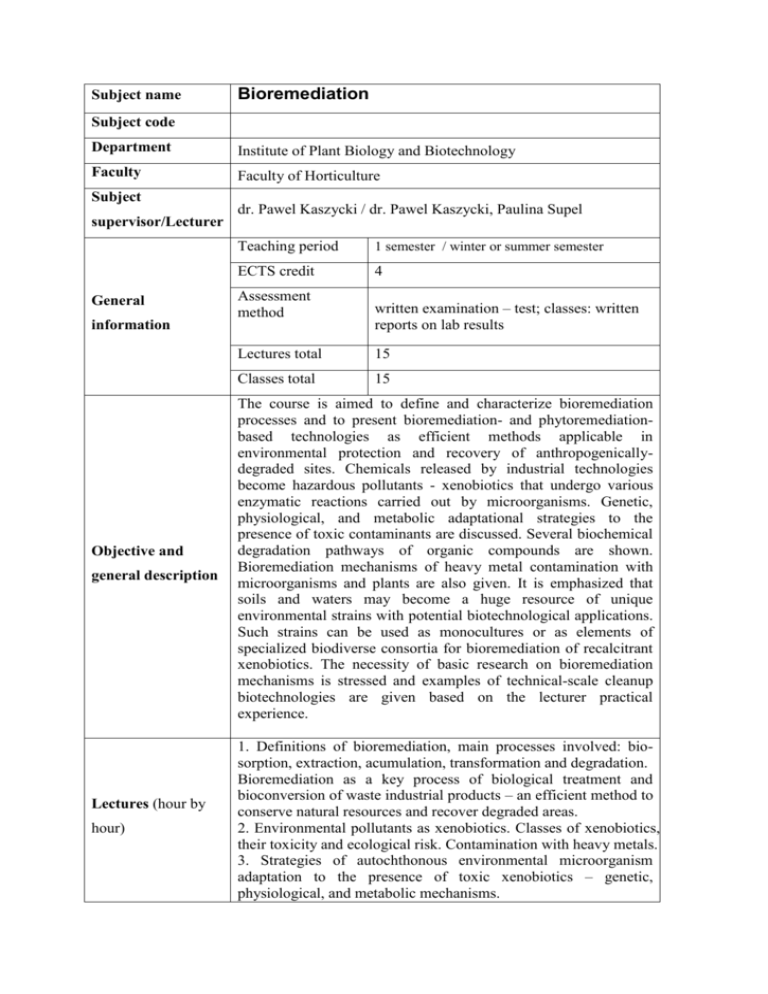
Subject name Bioremediation Subject code Department Institute of Plant Biology and Biotechnology Faculty Faculty of Horticulture Subject supervisor/Lecturer General information Objective and general description Lectures (hour by hour) dr. Pawel Kaszycki / dr. Pawel Kaszycki, Paulina Supel Teaching period 1 semester / winter or summer semester ECTS credit 4 Assessment method written examination – test; classes: written reports on lab results Lectures total 15 Classes total 15 The course is aimed to define and characterize bioremediation processes and to present bioremediation- and phytoremediationbased technologies as efficient methods applicable in environmental protection and recovery of anthropogenicallydegraded sites. Chemicals released by industrial technologies become hazardous pollutants - xenobiotics that undergo various enzymatic reactions carried out by microorganisms. Genetic, physiological, and metabolic adaptational strategies to the presence of toxic contaminants are discussed. Several biochemical degradation pathways of organic compounds are shown. Bioremediation mechanisms of heavy metal contamination with microorganisms and plants are also given. It is emphasized that soils and waters may become a huge resource of unique environmental strains with potential biotechnological applications. Such strains can be used as monocultures or as elements of specialized biodiverse consortia for bioremediation of recalcitrant xenobiotics. The necessity of basic research on bioremediation mechanisms is stressed and examples of technical-scale cleanup biotechnologies are given based on the lecturer practical experience. 1. Definitions of bioremediation, main processes involved: biosorption, extraction, acumulation, transformation and degradation. Bioremediation as a key process of biological treatment and bioconversion of waste industrial products – an efficient method to conserve natural resources and recover degraded areas. 2. Environmental pollutants as xenobiotics. Classes of xenobiotics, their toxicity and ecological risk. Contamination with heavy metals. 3. Strategies of autochthonous environmental microorganism adaptation to the presence of toxic xenobiotics – genetic, physiological, and metabolic mechanisms. Classes 4. 5. Aerobic and anaerobic metabolic pathways of biodegradation of toxic chemicals by pro- and eukaryotic microorganisms. Basic principle and examples of co-metabolism. Examples of unique enzymatic pathways present in bacteria and non-conventional yeast serving as a basis for elaborating methods of effective biodegradation of xenobiotics in wastewaters and polluted soils. 6. Bioremediation of heavy-metal contamination– basic processes: physical adsorption, metal uptake and metabolism, dissimilatory metal reduction, enzymatic and non-enzymatic bioreduction in microorganisms and plants; bioconversion into bioorganic complexes and biosequestration. 7. Phytoremediation of contaminants – synergy of bacterial, fungal and green-plant metabolism. 8. Bioremediation of xenobiotics in industrial effluents – elaboration of specialized activated sludges, construction of modern biological wastewater treatment systems. 9. 10. From basic research to biotechnological applications: modern trends in biochemical, genomic and proteomic studies of bioremediation mechanisms and detection of specific enzymatic activities; microbiological methods for isolation of natural strains isolated from polluted areas, their selection and adaptation to enable bioremediation of particularly recalcitrant contaminants, the use of molecular biology techniques to obtain mutant strains with defined enzymatic pathway modifications. 11. Use of monocultures, co-cultures and microbial consortia for bioremedaition. 12. Construction of biodiverse, multi-species microorganism communities, directed against xenobiotics of particular risk. The idea of biostimulation and bioaugmentation. 13. 14. 15. Examples of environmental practice – description of selected large-scale cleanup projects carried out by the team of Biochemistry Department: biodegradation of formaldehyde and methanol in industrial watewaters, biological treatment of biofuel production effluents, in-situ and ex-situ reclamation of soil polluted with organic compounds (paraffins, BTEXs, PCBs, PAHs, pesticides). Preliminary characterization of the MUT (methanol utilization) pathway of methylotrophic yeasts – the enzymatic pathway of biological oxidation of single-carbon (C1 ) xenobiotics.: observations of methanol biodegradation withe the method of gas chromatography (GC) – 5h. Regulation of the methylotrophic pathway reactions in methylotrophic yeasts: detection of inducible specific enzymes: alcohol oxidase, formaldehyde and formate dehydrogenases and identification of the mechanism of glucose catabolite repression (GCR) – 5h. Bioremedition of heavy metal contamination with microorganisms, as exemplified by chromium compounds: comparative electrophoretic (SDS-PAGE) analyses of bacterial and/or yeast protein profiles upon treatment with sublethal References concentrations of Cr(III) and Cr(VI) – 5h. 1. Augustynowicz J., Kaszycki P., Kuś M., Białecka A., Kołoczek H. (2008) Optimized methods for stabilization of microbial communities specializing in biodegradation of organic environmental contaminants. Polish Journal of Environmental Studies 17 (5): 655-664. 2. Kaszycki P., Czechowska K., Petryszak P., Międzobrodzki J., Pawlik B., Kołoczek H. (2006) Methylotrophic extremophilic yeast Trichosporon sp.: a soil-derived isolate with potential applications in environmental biotechnology. Acta Biochim Polon 53 (3): 463–473. 3. Kaszycki P., Fedorovych, D., Ksheminska, H., Babyak, L., Wójcik, D., Kołoczek, H. (2004): Chromium accumulation by living yeast at various environmental conditions. Microbiological Research 159 (1): 11-17. 4. Kaszycki P., Kołoczek H. (2002) Biodegradation of formaldehyde and its derivatives in industrial wastewater with methylotrophic yeast Hansenula polymorpha and with the yeast-bioaugmented activated sludge. Biodegradation 13: 9199. 5. Kaszycki P., Tyszka M., Malec P., Kołoczek H. (2001) Formaldehyde and methanol biodegradation with methylotrophic yeast Hansenula polymorpha. An application to real wastewater treatment. Biodegradation 12 (3):169-177. 6. Ksheminska, H., Fedorovych, D., Babyak, L., Yanovych, D., Kaszycki P., Koloczek, H. (2005): Chromium (III) and (VI) tolerance and bioaccumulation in yeast. A survey of cellular chromium content in selected strains of representative genera. Process Biochemistry 40 (5): 1565-1572. 7. Leahy J.G., Colwell R.R. (1990) Microbial degradation of hydrocarbons in the environment. Microbiol. Rev. 54: 305315. 8. Lovley D.R., Coates J.D. (1997) Bioremediation of metal contamination. Curr Opinion Biotechnol. 8: 285 - 289. 9. Reineke W. Development of hybrid strains for the mineralization of chloroaromatics by patchwork assembly. Annu. Rev. Microbiol. 52: 287-331, 1998. 10. van der Meer J.R., de Vos W.M., Harayama S., Zehnder A. J. B. (1992) Molecular mechanisms of genetic adaptation to xenobiotic compounds. Microbiological Reviews 56 (4): 677694. 11. van Hamme J.D., Singh A., Ward O.P. (2003) Recent advances in petroleum microbiology. Microbiology And Molecular Biology Reviews 67 (4): 503–549. 12. Wood T. K. (2008) Molecular approaches in bioremediation. Current Opinion in Biotechnology 19: 572–578.
